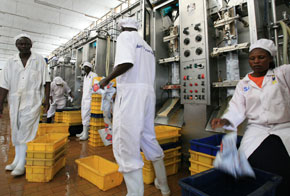
By Juma A. Okuku
After attaining independence in 1962, Uganda embarked on a process of industrialisation that would be disrupted by political turmoil in the intervening years. In the last 20 years though, President Museveni has talked about the need for Uganda to industrialise so as to be able to provide for its people. In this five-part insight, Juma A. Okuku looks at why we have failed so far and what we must do to succeed.
Industrialisation has become the buzzword in Uganda’s development and government policy circles. Uganda must industrialise. It is as well claimed that Uganda is at take-off stage! What is not explained is how industrialisation could occur, what it takes to industrialise, issues of policy and the institutional context for its successful realisation. The objective of this article is to raise the level of the debate on the industrialisation of Uganda.
Industrialisation is a complex process of social and economic change whereby a human group is transformed from a pre-industrial society into an industrial one. It is closely related to technological innovation and change in peoples’ attitudes toward their perception of nature. It is more than value addition to export commodities. Historically, it has involved a transition from agrarian, handicraft economy to one dominated by industry and machine manufacture, thus bringing about structural change in the economy.
Is this what the Ugandan politicians and policy-makers mean when they talk of industrialisation? If it is the case, then there are two critical questions that have not been closely examined: 1) Why is industrialisation important to a country? 2) What does it take for a country to successfully industrialise?
Why should Uganda industrialise?
Drawing on the experiences of the earlier industrialisers, industrialisation is essential to long-term development. Every country that has achieved sustained growth has also seen a structural transformation of its economy away from primary production toward industry and services. Industrial development is necessary to raise incomes and employment, diversify exports and extend markets. Manufacturing becomes a critical medium of structural transformation from a low-productivity, low-income economy into one which is dynamic and diversified. In resource-poor countries, industrialisation becomes the most viable option for prosperity and wealth generation. Industrialisation, therefore, stands out as a major solution to poverty and unemployment. While industrialisation is important, it cannot be successfully realised through slogans.
What does it take to industrialise?
First, is the existence of an organised ruling elite with a determined political will whose mission is industrial transformation. Second, the capacity to mobilise, control and direct finances to industry. The financial system is a major mechanism guiding the flow of savings and investment. It delimits the options of industrial policy and manages the financial flows to different industrial sectors. Third, the establishment of a system of technological acquisition and innovation through a process of learning.
Technological acquisition has never been automatic. In both early and late industrialisation, the idea was to catch-up technologically with the more advanced countries. Fourth, the cultivation of a concrete set of connections that link the state intimately and aggressively to particular social groups with whom the state shares a joint project of transformation. What Professor Peter Evans at University of California, Berkeley, refers to as embedded autonomy. These presuppose state intervention to bring about industrial transformation.
Earlier industrialisers
Earlier industrialisers deliberately intervened in the process through government policies. During the first industrial revolution, the British government intervened by restricting the movement of skilled craftsmen abroad to minimise the flight of technological capability. Similarly in the 18th and 19th Century, USA and Germany intervened vigorously in their economies. Since then, industrialisation has taken place under different circumstances. Countries setting out to industrialise have had to forge their own policies, sequences and ideologies to that end. But central to all of them was the acquisition of technological capability.
The nature and the role played by technical knowledge, separates industrial revolution in England, Germany and USA on one hand, from the industrialisation that occurred in the twentieth-century agrarian states. Industrialisation occurred in England on the basis of invention. To catch-up, USA and Germany industrialised on the basis of innovation. Japan and the other East Asian countries industrialised on the basis of learning through importing technology from abroad and assimilating, adapting and improving on it.
The earlier industrialisers, be they England, US, Germany or later industrialisers in East Asia Japan, South Korea Taiwan had two things in common. 1) They built particular institutions and designed appropriate policies to facilitate the process of industrial transformation. 2) The institutions and policies were buttressed by an overwhelming ideology of economic nationalism the belief in the use of state power to politically construct the competitive advantage of their respective national economies.
For Uganda, the motive should be to catch-up by bridging the gap with the developed countries, especially technologically, as speedily as possible. But the aspiration to industrialise must take note of the changed global circumstances for effective process of industrialisation. Most important to note are the differences in the character of institutions and industrial policies on which late industrialisation is based and managed.
It is these institutions and industrial policies that Uganda should learn. The success of policy is not derived from its definition as a good policy. The consistent pursuit of any policies, whether they are aimed at getting prices right or implanting local industry, requires the existence of a complex set of institutions, political and socio-economic machinery. Institutions define the way of behaviour, attitudes and actions to be taken.
East Asian experience
Why did East Asian countries, particularly South Korea and Taiwan, successfully industrialise and yet it has been a litany of disasters in Africa? The successful cases of industrialisation, particularly of East Asia, had as one of its central points, a set of institutional and political arrangements compatible with an appropriate mix of state intervention and market-orientation in the economy. The single foremost objective of the East Asian political leadership was to realise industrial transformation.
Specifically, this involved the construction of developmental states, carried out agrarian reforms, built institutions for technology transfer and innovation, established systems of collaboration and coordination between the private sector and the government. They made definite transitions from Import Substitution Industrialisation (ISI) to Export Oriented Industrialisation (EOI).
Drawing lessons from the Japanese experience as the pioneer of industrialisation by learning, the East Asian states, particularly South Korea and Taiwan, constructed similar institutions to launch their own industrialisation programmes.
First and foremost was the construction of developmental states. A developmental state exists when the state possesses the vision, leadership and capacity to bring about a positive transformation of society within a condensed period. A typical developmental state possesses a determined developmental elite, state autonomy, a powerful, competent and insulated bureaucracy, effective management of non-state economic interests, legitimacy and performance. Central to these is the transformative mission of the state.
The outcomes of these institutional arrangements are realised by the creation of state capacity and coherence. State capacities are enabled by the presence of a small but professional and efficient state bureaucracy. A political context is created where the bureaucracy is permitted to formulate policy and intervene in the economy without sabotaging competitive markets.
The critical elements in the bureaucracies in East Asia were meritocratic recruitment, competence and autonomous organisation. These gave the bureaucracy the capacity to produce competent assessments of economic problems from a point of view that did not simply reflect the interests of individual corporations or sectors. The existence of given agencies with a generally acknowledged leadership in economic area allows for a concentration of talent and expertise. These give economic policy coherence that lack in a less clearly organised state apparatus.
In Japan this was expressed through the Ministry of International Trade and Industry (MITI), in South Korea, Economic Planning Board (EPB) and Taiwan, in Council of Economic Planning and Development (CEPD) together with the Industrial Development Bureau (IDB) of the Ministry of Economic Affairs.
State control over finance
It is the control over finance that makes all states potentially “developmental†wherever they exist. The capacity to mobilise, control and direct finances to industry or to development in general, defines a developmental state. The financial system is a major mechanism guiding the flow of savings and investments. It delimits the options of industrial policy and manages the financial flows to different industrial sectors.
In Japan, in capital scarce years following World War 11, the Japanese state acted as a surrogate for the weakly developed capital markets. It also induced transformative investment decisions. State institutions from the postal saving system to Japan Development Bank (JDB), were crucial in getting the needed investment finance to industry.
The state was central to the provision of capital. This allowed MITI to acquire a central industrial policy role. MITI approved investment loans from Japan Development Bank. It had authority over foreign currency allocations for industrial purposes and licenses to import technology. With its ability to provide tax breaks and its capacity to provide “administrative guidance cartels†that would regulate competition in industry, MITI was in a perfect position to maximise induced decision-making in regard to the industrial sector.
In South Korea, after the coup in 1961 by General Park, major reforms placed all banks and investment decisions under the control of government. This was indeed the most important policy in the linkage between financial institutions, business groups and the government. By so doing, the government was able to fund priority targeted industries. Even social programmes initiated by government could easily be funded because government not only had access to bank capital but also the power to determine the priorities in national interest.
These reforms were carried out through a combination of incentives and coercion. This made all Korean enterprises subservient to governments guidance as they became dependent on it for funding their survival and expansion.
****
-Continues next week.
Dr. Juma Anthony Okuku is a lecturer in Political Economy at Makerere University, Kampala.
 The Independent Uganda: You get the Truth we Pay the Price
The Independent Uganda: You get the Truth we Pay the Price


